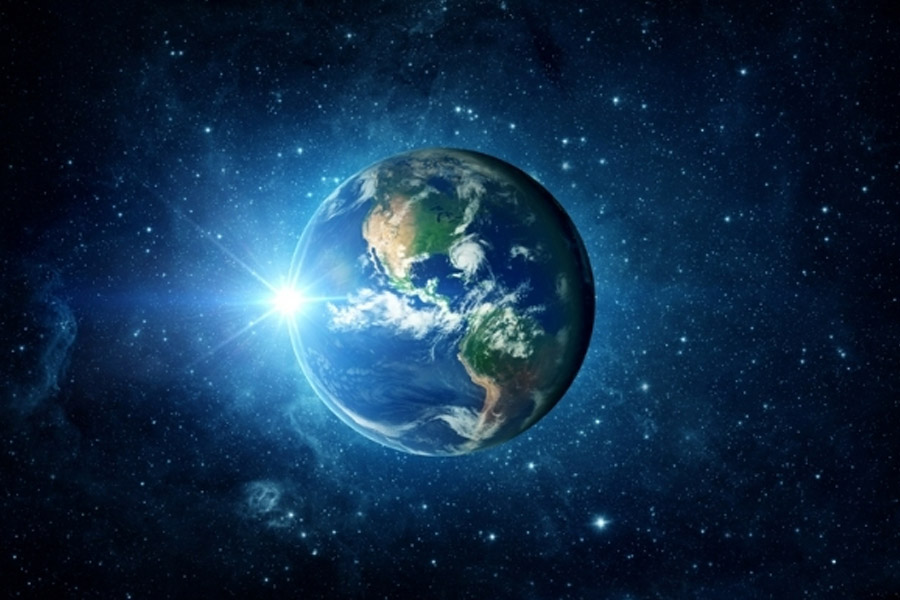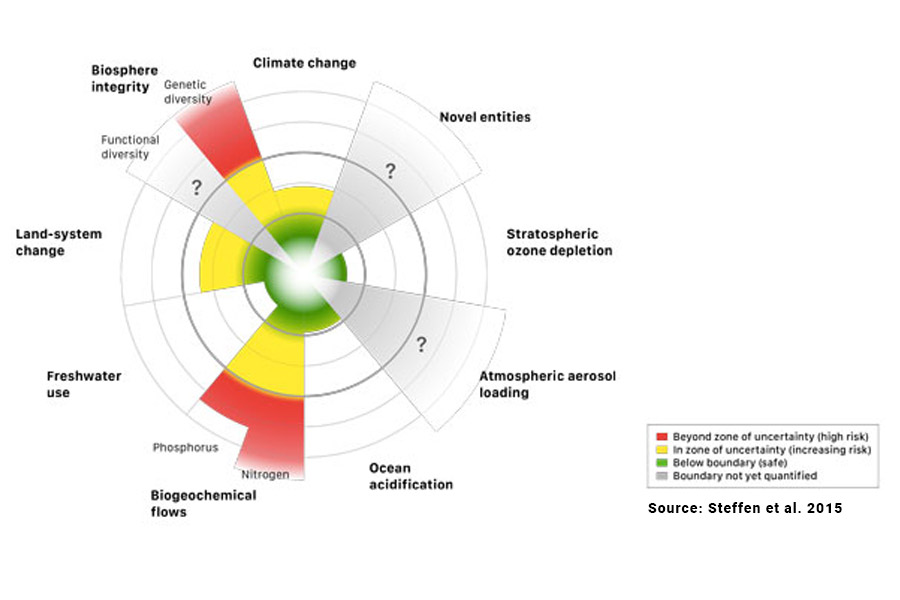
- Insight
- March 15, 2024
The 9 planetary limits: what are they?
The last fifty years of development of our economy have brought our Planet and its delicate mechanisms to the brink of collapse due to 9 planetary limits.
Since the Industrial Revolution, human impact on a global scale has been so great that scientists have declared the end of the Holocene, the geologic era characterized by low variability in the factors affecting our planet Earth, and the beginning of a new geologic era, the Anthropocene, in which humans are the main driver of change in natural systems. As evidence of this, floods, fires, hurricanes and other extreme weather events are now commonplace in every corner of the Planet.
In 2009, Swedish scientist Rockström and his team of researchers tried to put down on paper a framework called the nine planetary limits (Johan Rockström, 2009). The identified limits should not be exceeded on pain of unforeseen and absolutely irreversible changes that would jeopardize the proper functioning of the Earth System and thus the well-being and survival of humanity itself.
Unfortunately, in 2009 climatologists admitted that already 3 of these limits had already been exceeded: too much carbon dioxide put into the atmosphere, too much nitrogen removed from the atmosphere, and declining biodiversity. A new study published in the journalScience (Will Steffen, 2015) in 2015 tells us that we have exceeded due to unrestrained deforestation even the limit of land use change.
But what are the 9 planetary limits and the consequences closely associated with exceeding each limit?
Climate change
The Earth’s average temperature has already risen by nearly 1°C, and it is important to note that even staying within the 2°C threshold set by theParis Agreement in December 2015 would pose high risks of a deleterious climate impact on the environment and our society. Paleoclimatic data from the past 65 million years suggest how the decrease in atmospheric CO2 has been a major variable in causing the planet to cool over the long term. In parallel, we can see that at an atmospheric carbon dioxide concentration of 450 ppm, the planet has in its past history experienced a total absence of glaciers. To date, we have just over 400 parts per million of CO2 in the atmosphere, while the limit set by scientists to avert catastrophic effects is 350 ppm.
Among the various consequences of crossing this planetary limit are: the retreat of glaciers summer from the Arctic and major mountain ranges, glacier mass losses in Greenland and West Antarctica, rising sea levels, the 4° shift of the subtropical regions toward the poles, the bleaching of the coral reefs, the increase in the number of major floods and periods of drought.
Chemical pollution level
The cause of chemical pollution is a wide range of organic and inorganic compounds of human origin such as radioactive components and heavy metals. An estimated 80,000 to 100,000 chemicals have been released into the environment by humans. Although the scientific uncertainty of neurotoxicity remains for many of these substances, in general we can say that chemical pollution affects human health, for example by damaging the immune system, and the vulnerability of ecosystems.
The 2001 Stockholm Convention on Persistent Organic Pollutants effectively enshrined a planetary limit for a small group of substances such as PCBs, dioxins, DDT and other pesticides. At present, it is not possible to identify a precise planet-wide limit for this type of pollutant.
Ozone level in the atmosphere
The job of the ozone layer in the stratosphere is to filter out the sun’s ultraviolet rays. There are anthropogenic substances that can destroy the ozone layer, such as chlorofluorocarbons. With the signing of the Montreal Protocol in 1987, most of the sources that cause the emission of these ozone-depleting gases including chlorofluorocarbons were banned. The concentration of these gases in the atmosphere has stabilized and in some cases even decreased, although the negative effects will continue for many more decades.
The amount of atmospheric particulate matter
Particulate matter and all the various forms of particulate matter (aerosols) from burning coal, waste or gasoline are capable of affecting the climate and causing adverse effects on human health. PM 2.5 particulate matter is responsible for about 3 percent of deaths worldwide related to cardiopulmonary diseases and about 5 percent of tracheal, bronchial, and lung cancers. This is about 800,000 deaths a year, and the causes are directly attributable to pollution in urban and industrial areas.

The oceans currently absorb 25 percent of total human emissions through the dissolution of carbon dioxide in ocean waters and the absorption of carbon by marine organisms. Increased carbon dioxide in the oceans increases their acidity with negative consequences for many marine organisms, particularly those that use calcium carbonate ions to form shells or protective shells. If the current rate of ocean acidification, 100 times faster than at any other time in the last 20 million years, continued at this rate we would run the risk, among other consequences, of witnessing the death of coral reefs, which represent the 90% of marine biodiversity, already under pressure from rising sea temperatures.
The balance of nitrogen and phosphorus cycles.
Human interference in the nitrogen and phosphorus cycle has caused sudden and dangerous changes in the biochemistry of lakes and marine ecosystems. We have already far exceeded the safety threshold set by scientists for nitrogen. Human activity through industrial fixation processes that convert nitrogen to ammonia, agricultural processes in leguminous crops, and the burning of fossil fuels and biomass alone converts more molecular nitrogen (N2) from the atmosphere than all natural terrestrial processes combined. The threshold set by scientists within which human nitrogen fixation processes should stand is 35 Mt per year, or, 25 percent of the current value.
Phosphorus, a mineral that unlike nitrogen must be mined, is an indispensable fertilizer to ensure the results of modern industrial agriculture. 20 Mt per year are extracted, of which it is estimated that more than half end up in the oceans where they cause eutrophication and anoxic events. The planetary limit for phosphorus has been set by scientists 10 times the natural flux; to date, fluxes have reached 8-9 times the natural flux.
Freshwater consumption rate
The global limit for blue water use is set at around 4,000 km3 per year because exceeding this threshold would seriously jeopardize green water supplies and terrestrial and aquatic ecosystems. Current water withdrawal from rivers and lakes is about 2,600 km3 per year. Humankind still has some margin, even as pressures on water resources continue to increase due to the risingdemand for food from an ever-growing world population. It is estimated that by 2050, blue water consumption will increase from 25% to 50%.
Land use rate
Agricultural intensification is the main factor behind land use change; forests give space to crop fields or pastures. This conversion, at an average annual rate of 0.8 percent over the past 40-50 years, contributes to climate change (by decreasing the ability of ecosystems to absorb CO2), increased inputs of nitrogen and phosphorus to water, and loss of the planet’s biodiversity. The limit within which to allocate land for crops and pastures is 15 percent of the ice-free land area. In 2005, about 12 percent of the planet’s land was under cultivation, so scientists still consider there to be some room for an expansion of agricultural land of about 400 Mln hectares but it is highly likely that this limit will be reached within a few decades.
To stay within these limits, humanity should implement the following. measures to prevent the loss of soil fertility such as organic farming, build more efficient irrigation systems such as the drip system, change eating habits by decreasing both the consumption of animal products and per capita food consumption and waste in the distribution chain.
Percentage of biodiversity loss
Biodiversity plays an essential role in increasing the resilience of terrestrial systems. Ecosystems with a low level of diversity are more vulnerable to external shocks and therefore more at risk of a sudden and catastrophic downgrade in structural conditions. We are experiencing the sixth major extinction of life on the planet, and we should keep in mind that past extinctions have always led to permanent changes in the biotic composition and functioning of the Earth System. Currently 25 percent of known species are threatened with extinction. Among the causes of increased extinction rates are land-use changes (from forests to farmland), climate change, intensive fishing , and contamination of the environment by chemical pollutants.
The average rate of past extinction, estimated through the study of the fossil record, is between 0.1 and 1 species per million per year. To date, the extinction rate stands at 100 species per million per year. In terms of biodiversity loss so we have already entered the dangerous red area. The extinction rate urgently needs to be brought back to around 10 species per million, and efforts must also be made to ensure the survival of those species deemed most important for ecosystem functioning, such as corals or certain types of algae.
The crucial aspect to consider is that the planetary boundaries are all deeply connected and once one is crossed, the risks of crossing the others begin to multiply as well.
Recent work monitoring these limits, conducted by Rockström and his researchers, highlights how, for the first time in human history, we are being forced to consider the real risk of destabilizing the entire planet. The younger generation sees this and does not hesitate to take to the streets to ask us to take action; however, it is often not easy to understand, objectively and concretely, what problems we are seeking justice for and their magnitude.
This kind of scientific framework, within everyone’s reach, helps us get a better idea of the problems we face, clearly highlighting where we are and where we need to act most urgently.
Society and science must act toward one goal: the stabilization of our Planet. We need to drastically reduce global emissions as soon as possible by decarbonizing the most energy-intensive sectors. We must transform agriculture, from an emissions source to a carbon sink, and we must seriously protect our oceans and natural ecosystems that absorb half of our emissions.
The good news is that we can do it. We have the technology, we have the knowledge, and above all, the realization is maturing in each of us that it makes sense to do it, both socially and economically. This is our only home. Preserving it is our mission to protect the future of our children.

